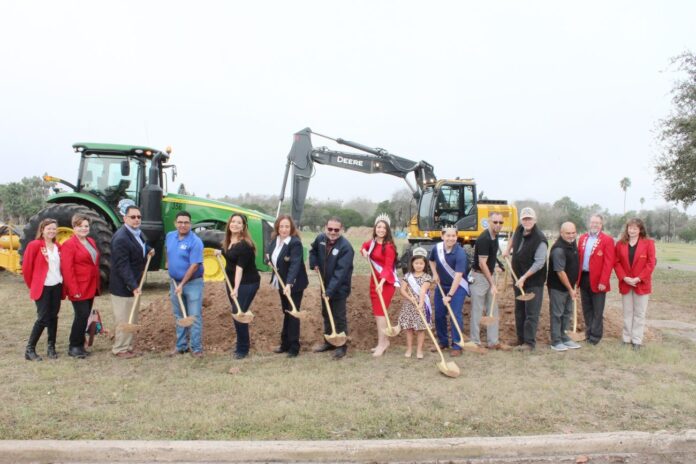WESLACO — City leaders here broke ground on the latest in a series of drainage improvement projects sparked after catastrophic flooding wracked the region in June 2018.
Within six weeks, the flat expanse of grassy land that sits nestled between the city cemetery and Leisure World RV Park on the city’s south side will be transformed into a 3-acre regional detention facility that local leaders hope will prevent the kinds of flooding the summer 2018 storm caused.
“Hopefully, (it) keeps the water from going into the residences, in particular, the surrounding area, but more importantly, the RV park,” Weslaco Mayor David Suarez said after the groundbreaking ceremony Thursday morning.
“It got anywhere from 3 to 4 feet of water. This is going to alleviate that and we’re gonna be able to retain more water in this RDF and then bleed it back into the drainage canal that goes out to the outfall,” the mayor said. He added that the city was able to take on the project after purchasing the land from a local landowner.
Thursday’s groundbreaking marked the beginning of the second major drainage improvement project to be funded with $4 million in certificates of obligation approved by the Weslaco City Commission in November 2018.
The first project — a nearly 4-acre RDF on Farm-to-Market Road 88 behind a Dollar General store also on the south side of Weslaco — was completed in the fall. And next on the list is another RDF to be located along Pleasantview Drive.
“Halff and Associates was the engineering firm hired by the city to come in and give recommendations on drainage projects. That’s where the eight projects came from,” explained Weslaco resident David Menchaca, chairman of the Weslaco Drainage Advisory Board.
Now a permanent fixture of the city’s list of advisory committees, Menchaca has served on the WDAB since its initial inception as an ad hoc committee a year-and-a-half ago. He said he was spurred to join the group after his home in Southland Heights flooded twice — after years of reporting known drainage issues to city leaders.
Menchaca said the committee has worked hard to be equitable in prioritizing the laundry list of drainage projects needed throughout town. The group chose to give highest priority to those projects that would impact the largest number of residents while simultaneously being the most cost effective.
“To give you an example, the project that’s gonna specifically help my house is almost one of the last ones, because, like I said, we decided to do it (based) on what would help the most people the soonest for the least amount of money,” Menchaca said. “And those are the ones that were put at the beginning.”
It’s been 19 months since a 500-year storm wreaked havoc on the Mid-Valley and Hidalgo County. In that time, Weslaco leaders identified nearly 90 drainage projects that engineers estimated would take 15-20 years to complete, Mayor Suarez said.
And also in that time, the city has borrowed $14 million to begin the work, has purchased heavy machinery to address smaller projects, like ditch cleaning and widening, and has partnered with the county to undertake more than 30 additional projects throughout Hidalgo County Precinct 1 alone.
It’s a project pace the mayor characterized as “aggressive.” “I think we’re on track — or ahead of the timeline now, because this is our second RDF. We already completed one,” Suarez said.
“We bought the land over in Pleasantview and we should go to construction in six weeks, so I think that’s pretty aggressive,” he said.
For Menchaca, serving on the WDAB has taught him that — even though the projects take time, and not all projects directly impact all residents — each project is essential because all the floodwaters drain toward the same place: the floodway.
“When people say, ‘Well, this is not gonna help me’ and they live on the south part of town, indirectly, it will,” Menchaca said. “Because this water gets held, so that’s less water in the ditches fighting everybody with everybody’s else’s water to try to get into the floodway. So it does help everybody, indirectly.”





